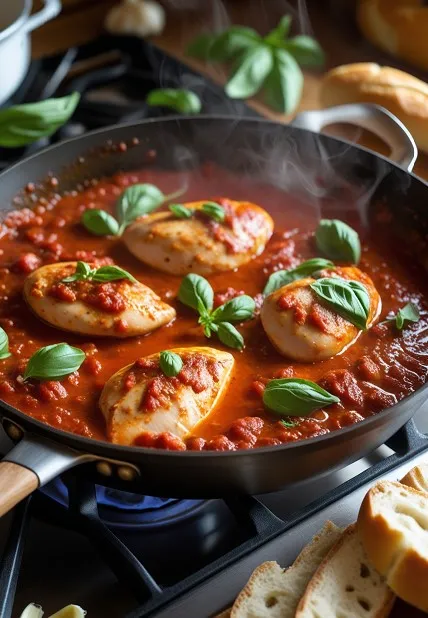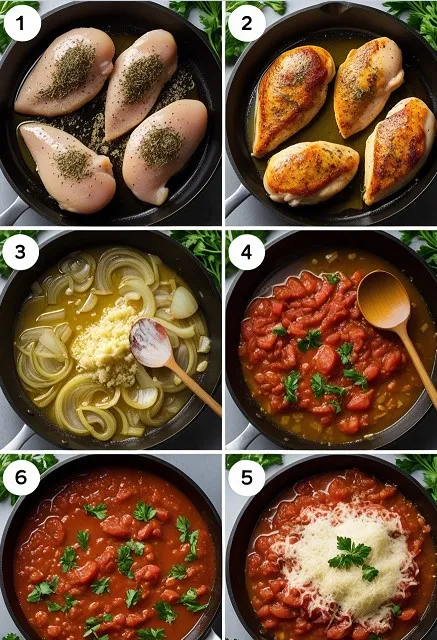Are you looking for a comforting yet simple dish that brings together succulent chicken and a rich tomato sauce? Then you’ve come to the right place. Today, we will explore all the ins and outs of chicken marinara, a timeless recipe that appeals to both newcomers in the kitchen and experienced cooks seeking a hearty meal. In addition, we will delve into useful tips, variations, substitutions, and best practices for storing your finished dish. We will also answer your most frequently asked questions and provide pointers for turning this recipe into a crowd-pleasing favorite.
However, before we begin, let us set the scene: imagine savoring the aroma of garlic, basil, and tomatoes simmering gently on the stove. Picture tender chicken breasts nestled in a robust sauce that has been infused with layers of flavor. Therefore, if you’re on a quest for a dish that is big on taste yet comparatively low on hassle, chicken marinara truly delivers. In this blog post, you will learn the step-by-step method for creating an unforgettable meal. In addition, you will discover tips on how to make it healthier or adapt it for different dietary preferences.

Despite popular belief, chicken marinara does not require advanced chef skills. Conversely, the dish comes together easily with the right balance of fresh ingredients and savory seasonings. In fact, cooking it at home often results in a more flavorful meal than you might find in some restaurants. Therefore, get ready to roll up your sleeves and treat yourself or your loved ones to a delicious meal. Rest assured, the entire process will be broken down into manageable steps. Moreover, you will feel encouraged throughout, since the recipe is approachable and rewarding. Let’s begin this culinary journey together and learn how to perfect your chicken marinara masterpiece.
Ingredient List chicken marinara
Below, we detail the essential ingredients you need for a classic chicken marinara. In addition, feel free to explore substitutions to cater to your dietary preferences or availability of items:
- 4 boneless, skinless chicken breasts (approximately 1 pound total)
- 2 tablespoons olive oil
- 1 medium onion, finely chopped
- 3 garlic cloves, minced
- 1 teaspoon dried oregano
- 1 teaspoon dried basil
- 1 teaspoon salt (or to taste)
- 1/2 teaspoon black pepper (or to taste)
- 2 cups canned crushed tomatoes (preferably low-sodium)
- 1/2 cup chicken broth (low-sodium preferred)
- 1/2 teaspoon sugar (optional, to balance acidity)
- 1 tablespoon chopped fresh parsley (reserve extra for garnish)
- 1/4 teaspoon red pepper flakes (optional)
- 1/4 cup grated Parmesan cheese (plus extra for serving)
In addition, you can incorporate optional ingredients such as fresh basil leaves, a splash of balsamic vinegar, or even a pinch of smoked paprika for a bit of uniqueness. However, the core ingredients listed above will yield a classic chicken marinara bursting with savory and aromatic flavors.
Step-by-Step Instructions chicken marinara

1. Prepare the Chicken
First, pat your chicken breasts dry with paper towels. This step will help promote even browning when you cook them. If they are particularly thick, you may want to pound them slightly for uniform thickness. Therefore, consider placing the chicken between two sheets of plastic wrap and using a mallet to even everything out. This ensures all pieces require roughly the same cooking time.
2. Season the Chicken
In a small bowl, combine salt, pepper, oregano, and basil. Next, sprinkle this mixture over the chicken breasts evenly. Gently press the seasonings into the meat to help them adhere. This step forms the foundation of your flavor profile and allows for a well-balanced taste.
3. Sear the Chicken
In a large skillet, heat the olive oil over medium-high heat. Once the oil shimmers, add the chicken breasts. Cook for about 3 to 4 minutes on each side, or until they take on a light golden color. However, do not worry if they are not fully cooked at this point; we will continue cooking them in the marinara sauce. After searing, remove the chicken from the skillet and set it aside.
4. Sauté Onions and Garlic
Using the same skillet, add the finely chopped onions. Stir occasionally for about 4 to 5 minutes, or until the onions become translucent. In addition, add the minced garlic and sauté for about 30 seconds. You’ll want to be mindful not to burn the garlic, as it can quickly turn bitter. Therefore, reduce the heat slightly if you notice any excessive browning.
5. Build the Marinara Sauce
Next, pour in the canned crushed tomatoes along with the chicken broth. Stir in the sugar (if you are using it), fresh parsley, and any additional seasonings like red pepper flakes or a pinch of smoked paprika. In addition, taste the sauce and adjust the salt and pepper to your liking. At this point, your kitchen will begin filling with the enticing aroma that defines chicken marinara.
6. Simmer the Sauce
Bring the mixture to a gentle boil, then reduce the heat to low and let it simmer for about 5 to 7 minutes. This step allows the flavors to meld together. In addition, keeping it at a slow simmer helps develop depth without scorching the sauce. Therefore, be sure to stir occasionally and monitor the texture, adding a splash of water if you notice the sauce is becoming too thick.
7. Return the Chicken to the Sauce
Carefully nestle the partially cooked chicken breasts back into the sauce. Ensure each piece is submerged about halfway for uniform cooking. Cover the skillet with a lid and let the chicken simmer for about 10 to 15 minutes, or until the internal temperature reaches 165°F (74°C). Therefore, use a meat thermometer to ensure it is fully cooked. In addition, taste the sauce and verify that the seasonings are balanced.
8. Add Cheese and Final Touches to chicken marinara
Sprinkle the grated Parmesan cheese over each chicken breast. Cover the skillet again, and let the cheese melt for about 2 minutes. Garnish with extra parsley or fresh basil if desired. Furthermore, taste your completed chicken marinara one final time. Making small seasoning adjustments at this stage can greatly enhance the overall flavor. Finally, remove the skillet from the heat.
Helpful Tips to perpare chicken marinara
• Use high-quality chicken: Fresh, ethically sourced chicken makes a substantial difference in taste and texture. In addition, trimming visible fat can make the dish leaner and healthier.
• Try fresh herbs: If available, incorporate fresh basil or oregano. However, dried herbs still deliver a robust flavor profile if used correctly.
• Adjust thickness: If the sauce is too thin, simmer it uncovered for a few minutes. Conversely, if it’s too thick, add extra broth or a splash of water.
• Pre-make the sauce: Feel free to prepare a batch of marinara sauce in advance. Therefore, you can freeze it or store it in the fridge for up to a week.
• Spice variation: For a spicier version, add more red pepper flakes or diced jalapeños. In addition, you can incorporate chili powder for an extra kick.
Potential Substitutions and Variations
• Protein alternatives: Instead of chicken breasts, you can use chicken thighs for a juicier result. If you prefer a vegetarian option, substitute the chicken with firm tofu or hearty vegetables like eggplant.
• Gluten-free: Ensure your chicken broth is certified gluten-free. Serve the dish over gluten-free pasta or zucchini noodles for a lower-carb version. In addition, check ingredient labels for hidden sources of gluten.
• Lower-fat: Reduce or eliminate the cheese, and use less oil for sautéing. However, keep in mind that some fat helps deliver a richer flavor.
• Extra veggies: In addition, boost the nutritional value by adding slices of bell peppers or mushrooms. Sauté them alongside your onions so that they develop a robust taste.
• Dairy-free: Omit the Parmesan cheese or use a dairy-free alternative. Many plant-based cheeses melt well and complement the sauce nicely.
Frequently Asked Questions (FAQ)
1. Can I use store-bought marinara sauce?
Yes, you can use your favorite store-bought marinara sauce for convenience. However, making it from scratch typically yields a fresher, more vibrant taste. Therefore, it’s worth investing a little extra time when possible.
2. How do I know when the chicken is fully cooked?
Use a meat thermometer inserted into the thickest part of the breast. In addition, look for an internal temperature of 165°F (74°C). If you prefer not to use a thermometer, cut into the chicken to check if the juices run clear.
3. What sides pair well with chicken marinara?
Try pairing chicken marinara with spaghetti, garlic bread, or a simple garden salad. Therefore, you’ll have a well-rounded meal that appeals to various taste preferences. In addition, roasted vegetables or mashed potatoes make excellent complements to the dish.
4. Can I make it spicy?
Absolutely! Increase red pepper flakes or add fresh chili peppers for added heat. In addition, consider a spicy seasoning blend such as Cajun or chipotle for a smokier flavor profile.
5. Is this recipe freezer-friendly?
Yes. In fact, you can freeze leftover chicken marinara for up to three months. However, ensure you cool it fully before transferring it to an airtight container.
Storage and Reheating Instructions
After cooking your chicken marinara, let it cool slightly. Then, transfer it to a glass or BPA-free plastic container. Seal the container tightly and store it in the fridge for up to three days. However, if you plan on keeping it for longer, freezing is a good option. Therefore, label and date your frozen portions, as they’ll keep for up to three months. When you’re ready to enjoy your leftover chicken marinara, let it thaw in the refrigerator overnight. In addition, reheat on the stovetop or in the microwave until it reaches a safe internal temperature. Stir occasionally to maintain a consistent texture.
Conclusion
Chicken marinara is a versatile and crowd-pleasing meal perfect for busy weeknights or a casual gathering with friends. The combination of tender chicken, tomato-based sauce, and flavorful seasonings makes this dish a winner. However, don’t let its simplicity fool you; the end result is truly special, especially when served with your favorite sides.
Moreover, you can customize chicken marinara by exploring different substitutions and variations. Whether you choose to go gluten-free, dairy-free, or decide to mix in some extra veggies, chicken marinara to be informative, approachable, and inspiring. Remember to keep cooking, keep experimenting, and above all, savor every delightful bite.
